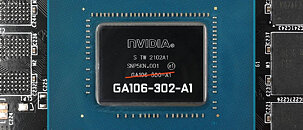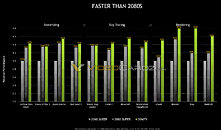
NVIDIA's Tiny RTX 4000 Ada Lovelace Graphics Cards is now Available
NVIDIA has begun selling its compact RTX 4000 Ada Lovelace graphics card, offering GeForce RTX 3070-like performance at a mere 70 W power consumption, allowing it to fit in almost all desktop PCs. The low-profile, dual-slot board is priced higher than the RTX 4080 as it targets professional users, but it can still be used in a regular gaming computer. PNY's RTX 4000 Ada generation graphics card is the first to reach consumer shelves, currently available for $1,444 at ShopBLT, a retailer known for obtaining hardware before its competitors. The card comes with four Mini-DisplayPort connectors, so an additional mDP-DP or mDP-HDMI adapter must be factored into the cost.
The NVIDIA RTX 4000 SFF Ada generation board features an AD104 GPU with 6,144 CUDA cores, 20 GB of GDDR6 ECC memory, and a 160-bit interface. With a fixed boost frequency floating around 1560 MHz to reduce overall board power consumption, the GPU is rated for just 70 Watts of power. To emphasize the efficiency, this card requires no external PCIe power connector, as all the juice is fed through the PCIe slot. The GA104 graphics processor in this configuration delivers a peak FP32 performance of 19.2 TFLOPS, comparable to the GeForce RTX 3070. The 20 GB of memory makes the card more valuable for professionals and AI researchers needing compact solutions. Although the card's performance is overshadowed by the recently launched GeForce RTX 4070, the RTX 4000 SFF Ada's professional drivers, support for professional software ISVs, and additional features make it a strong contender in the semi-professional market. Availability and pricing are expected to improve in the coming weeks as the card becomes more widely accessible.More images, along with specification table, follow.
The NVIDIA RTX 4000 SFF Ada generation board features an AD104 GPU with 6,144 CUDA cores, 20 GB of GDDR6 ECC memory, and a 160-bit interface. With a fixed boost frequency floating around 1560 MHz to reduce overall board power consumption, the GPU is rated for just 70 Watts of power. To emphasize the efficiency, this card requires no external PCIe power connector, as all the juice is fed through the PCIe slot. The GA104 graphics processor in this configuration delivers a peak FP32 performance of 19.2 TFLOPS, comparable to the GeForce RTX 3070. The 20 GB of memory makes the card more valuable for professionals and AI researchers needing compact solutions. Although the card's performance is overshadowed by the recently launched GeForce RTX 4070, the RTX 4000 SFF Ada's professional drivers, support for professional software ISVs, and additional features make it a strong contender in the semi-professional market. Availability and pricing are expected to improve in the coming weeks as the card becomes more widely accessible.More images, along with specification table, follow.













































